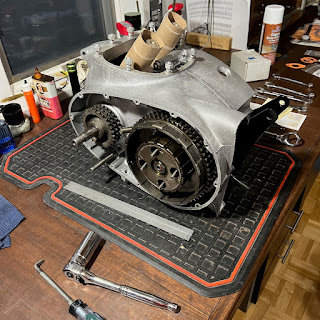The wiring on the Lightning Rocket was in poor shape. The original wiring harness and switches remained while someone had started a 12V conversion. There was a Zener diode with its cooling plate mounted on the front end, a 12V ammeter in the headlight shell, and a 12V transistor block in the back. Pieces were disconnected in various places showing it was still a work in progress. Time for an intervention.
The electrical system in the '64 BSA was a bit funky if you ask me. In the days before NASA's space program there was not a good solution for voltage regulation in a size that worked well for a motorcycle. Fortunately Lucas had an answer.
Their solution was a 6 volt system with a dual output alternator to keep things supplied with power. One winding powered the ignition system and another powered the lights. The lighting coil put out just enough juice to keep the lights on and with its limited output overcharging the battery was not an issue. The more power that came out of the alternator the brighter the lights became. If the battery was drained you could engage an AC current path from the alternator directly to the coils to fire it up. This was called an emergency starting circuit. I thought very briefly about keeping the 6 volt system but ultimately moved to 12 volts.
I decided to go with a reproduction 6V "made in England" wiring harness attached to a high output Lucas alternator controlled by a Sparx box. A Trispark ignition is mated to Trispark coils. The funky 6 volt bits will be unhooked and taped up. I also routed a ground line, using the unhooked 6 volt bits, to the headlight as the original system relied on frame grounding. This was problematic in the good 'ol days and not workable with a powder coated frame. A ground wire was also run to the tail light housing.
























































